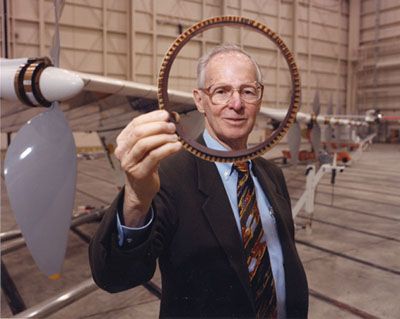Electric Aircraft

I hadn’t seen this idea per se, but I’m aware that there are thousands of people who have been hard at work developing this basic concept for quite a while. I’m quite sure that we’ll eventually see electric transportation exported to the skies, though it will be slow to come about, given the gravimetric and volumetric energy- and power-densities of current battery technologies.
I’ve done a lot of work with Aerovironment over the years, and I note that it was the company’s founder, the late Dr. Paul MacCready who brought this concept to the forefront of our imagination a couple of decades ago.

I would say that the best near term opportunity for widespread electric aeroplanes would be electrically assisted gliders – designed to operate mostly as gliders but with an electric motor used to enable take off and to act as a range extender if there are not enough thermals to keep the glider flying for as long as the pilot might like.
Using Alta devices flexible Galium Arsenide solar panels (28% efficient and only a gram a watt), and a modest battery a glider should be able to fly all day with an occasional solar assisted climb.
Craig,
There will probably never be electric aircraft beyond these curious exercises.
There’s no justification for them… and there’s no plausible path from here to there.
For a 737, you get between 0.4 and 0.6 miles/gallon… depending on the length of the flight (lift-off is a massive fuel burn, so the longer the flight the better the mileage).
The turbofan engine is extremely efficient, so it’s likely that switching to an electric propeller option will not improve the thrust efficiency more than ~30%.
If we wanted to fly a 737 at average speed for 1000 miles, it would take ~2000 gallons of jet fuel, or ~72.2 MWh of stored energy. Assuming that the thrust efficiency improved a full 30%, that means you’d need 50.5 MWh of onboard battery storage.
With modern best-case lithium-ion batteries, that would add 95 tons (!!!!) of energy storage, while reducing the need to store ~7 tons of jet fuel. It would also require ~75 m3 of space… Both of these requirements do not take into consideration cooling systems or frames.
A modern 737, when fully fueled, has a max take-off weight of 75 tons.
The only way that an electric aircraft can fly is if everything is minimalized – minimum weight for everything, minimum profile, traveling at speeds of less than 100 mph, etc…
There’s no commercial appetite for that. It’s just ludicrous.
Correct. And what’s more ludicrous is the title of the article: “Why One Little Plane Will Change Flight Energy Technology Forever.” Completely false.